Whether you're painting a wall or a canvas, getting the perfect color matters. Lilac is on-trend as a light accent color for a painted chair or a bold statement wall. Painting the whole room can transform the space into a tranquil paradise. But with all paint projects, it's important to ensure the color you see in the can is the color that will dry on your project. Painting with lilac means finding the right blend to mix.

Video of the Day
Match the Color
Purple can be a tricky color to mix, and no one wants their project to look like an explosion of grape jelly. For this paint, finding the ideal sample can help avoid any mix-ups when it comes to mixing. If you prefer to have a paint specialist at a home improvement store mix your paint, start with the sample paint card section and see if they have your perfect blend premade. Since lilac is becoming a popular choice in home décor, it's possible that it's already available for purchase. If it's not, snagging a few sample cards in various shades of purple can help when mixing your own paint for comparison. The paint specialist can help you as well, and it's easier to hold up a shade of eggplant purple as an example of what you don't want in your lilac mix.
Video of the Day
Get Crafty: Mixing
Mixing your own custom color starts with knowing the fundamental colors of lilac: red, blue and white. It may seem like you're painting an American flag, but the base colors of purple are a mix of the primary colors red and blue. Since these two colors come in a wide variety of shades, you'll need to find paint samples that have cooler tones of blue and red. Choose a red that leans toward pink, rose or mauve rather than bright orange or fiery yellow. For blue, a cool cobalt or Caribbean blue is preferable to a navy or dark blue. The darker your base colors are, the darker your purple will be. If you start with pastel and lighter blues and reds, your purple will be lighter.
Remember to note how much of each sample color you used when mixing. Breaking up the sample into thirds or fourths will help when you have to replicate the color. A plastic teaspoon can be used as a measuring tool as well. One part blue plus one part red is a good starting point.
If you've found a paint color similar to lilac, like a violet or a light purple shade, this will save a step. Your purple will need to be either lightened or darkened depending on your base mix of purple.
Lighten Up: Add White Paint
If your purple base is too dark, you'll need to add white paint to lighten it. When you pick up your paint samples, double up on the white. It'll be the one paint used the most while you test your colors. Again, keep track of how much you use so you can replicate it on a larger scale. Start with one part white, stir and continue to add more until the color matches your ideal lilac color. If it gets too pale, adding more of the base colors will even it out.
If your purple base is too light, you'll need to add a gray or lighter shade of black paint to darken the hue. If you use black paint, use half of a test size since a little goes a long way.
Test it Out
Before buying gallons of paint to make your mix, test out your mixed color. You may find that it doesn't look the same dry as it did wet. Find a test patch of space on your wall or project and apply. If the wall is brightly colored, apply a primer or white color to ensure color accuracy. Let your paint dry for 24 hours, and see how it looks. For a bold wall or entire room coating, put the test spot in an area that will allow you to see how the color looks in both natural sunlight and artificial lighting.
If you're satisfied with the test patch, congratulations! You have your lilac color. Buy the needed gallon amount for the square footage of the project, and repeat your mixing process large scale by using equal parts red, blue, white or purple that you used in the sample mix.